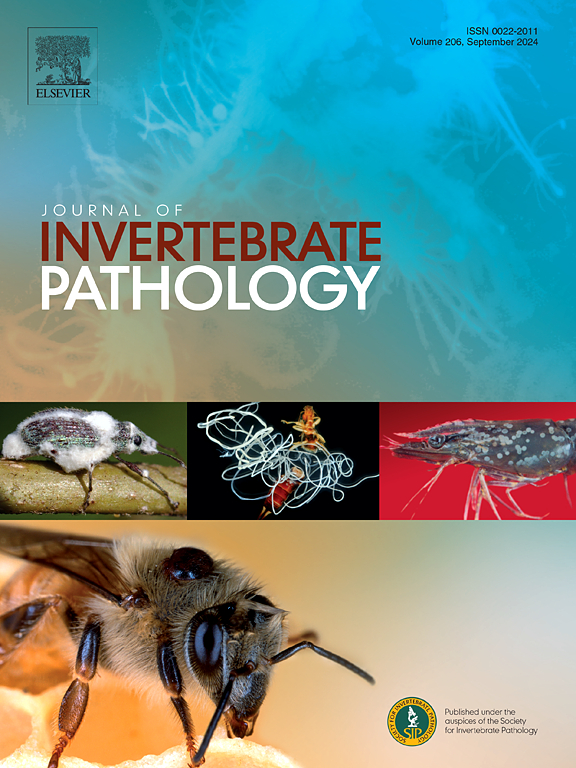Diverse viral communities inhabit the guts of date palm rhinoceros beetles (Oryctes spp.)
IF 3.6
3区 生物学
Q1 ZOOLOGY
引用次数: 0
Abstract
Two species of palm tree pests, Oryctes elegans and Oryctes agamemnon (Coleoptera: Scarabaeidae), cause significant damage to date palm trees (Phoenix dactylifera) in many countries in the Middle East. Despite several decades of research and the implementation of numerous control strategies, including mechanical, chemical, regulatory, and biosecurity measures, managing these pests remains challenging. Control of O. rhinoceros in the Pacific using an entomopathogenic virus is a landmark of classical biological control. In this study, we used a transcriptomic approach to examine the virome of populations of two Oryctes species across various regions in southern Iran, with the hope of discovering natural viral pathogens as potential biocontrol agents. Total RNA was extracted from a pool of larval gut samples and sequenced using the Illumina NovaSeq 6000. After analysing the RNA-Seq data, 28 novel virus sequences, including a diverse range of RNA and DNA viruses, were identified. Phylogenetic analyses revealed that these newly discovered viruses are evolutionarily linked with other closely related members in several families, including Partitiviridae, Picobirnaviridae, Totiviridae, Dicistroviridae, Tombusviridae, Nodaviridae, Potyviridae, Endornaviridae, Circoviridae and some unassigned viruses such as Negevirus and Jivivirus. Given the similarity of some of these viruses to plant viruses, and viruses reported from fungi and protists and their unclear host association, we have tentatively named them “Oryctes-associated viruses.” This study uncovers the great diversity of viruses in Oryctes species; however, further studies are necessary to determine their natural incidence, geographical distribution, impact on their hosts, and their potential as biological control agents for these significant date palm pests.

不同的病毒群落栖息在椰枣犀牛甲虫的内脏中。
在中东许多国家,两种棕榈树害虫,即elegans Oryctes和agamemnon Oryctes(鞘翅目:金龟科),对枣椰树(Phoenix dactylifera)造成了严重的危害。尽管进行了数十年的研究并实施了多种控制策略,包括机械、化学、监管和生物安全措施,但管理这些害虫仍然具有挑战性。利用昆虫致病病毒控制太平洋犀牛是经典生物防治的一个里程碑。在这项研究中,我们使用转录组学方法检测了伊朗南部不同地区两种Oryctes物种种群的病毒组,希望发现天然病毒病原体作为潜在的生物防治剂。从幼虫肠道样本中提取总RNA,并使用Illumina NovaSeq 6000进行测序。在分析RNA- seq数据后,鉴定出28个新的病毒序列,包括各种各样的RNA和DNA病毒。系统发育分析表明,这些新发现的病毒在进化上与几个科的其他近缘成员有亲缘关系,包括Partitiviridae、Picobirnaviridae、Totiviridae、Dicistroviridae、Tombusviridae、Nodaviridae、Potyviridae、Endornaviridae、Circoviridae以及一些未分配的病毒,如nevirvirus和Jivivirus。考虑到其中一些病毒与植物病毒的相似性,以及从真菌和原生生物中报道的病毒及其不明确的宿主关联,我们暂时将它们命名为“oryces -associated virus”。这项研究揭示了水稻物种中病毒的巨大多样性;然而,需要进一步研究它们的自然发病率、地理分布、对寄主的影响以及它们作为枣树重要害虫生物防治剂的潜力。
本文章由计算机程序翻译,如有差异,请以英文原文为准。
求助全文
约1分钟内获得全文
求助全文
来源期刊
CiteScore
6.10
自引率
5.90%
发文量
94
审稿时长
1 months
期刊介绍:
The Journal of Invertebrate Pathology presents original research articles and notes on the induction and pathogenesis of diseases of invertebrates, including the suppression of diseases in beneficial species, and the use of diseases in controlling undesirable species. In addition, the journal publishes the results of physiological, morphological, genetic, immunological and ecological studies as related to the etiologic agents of diseases of invertebrates.
The Journal of Invertebrate Pathology is the adopted journal of the Society for Invertebrate Pathology, and is available to SIP members at a special reduced price.

 求助内容:
求助内容: 应助结果提醒方式:
应助结果提醒方式:


